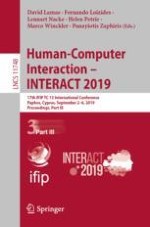2019 | OriginalPaper | Buchkapitel
Welcome, Computer! How Do Participants Introduce a Collaborative Application During Face-to-Face Interaction?
verfasst von : Mateusz Dolata, Susanne Steigler, Fiona Nüesch, Ulrike Schock, Doris Agotai, Simon Schubiger, Mehmet Kilic, Gerhard Schwabe
Erschienen in: Human-Computer Interaction – INTERACT 2019
Aktivieren Sie unsere intelligente Suche, um passende Fachinhalte oder Patente zu finden.
Wählen Sie Textabschnitte aus um mit Künstlicher Intelligenz passenden Patente zu finden. powered by
Markieren Sie Textabschnitte, um KI-gestützt weitere passende Inhalte zu finden. powered by
